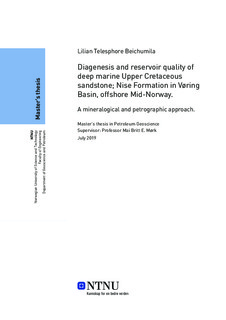| dc.contributor.advisor | Professor Mai Britt E. Mørk | |
| dc.contributor.author | Lilian Telesphore Beichumila | |
| dc.date.accessioned | 2019-10-03T14:00:38Z | |
| dc.date.available | 2019-10-03T14:00:38Z | |
| dc.date.issued | 2019 | |
| dc.identifier.uri | http://hdl.handle.net/11250/2620155 | |
| dc.description.abstract | The present study deals with diagenesis and reservoir quality of deep marine (> 1.2 km water depth) Upper Cretaceous sandstones in Vøring Basin. Mineralogical and petrographical analysis has been done on the cored interval from well 6707/10-1. The study focuses in the petrographic understanding, diagenetic development and their influence on reservoir quality.
The studied samples are mineralogically and textually matured, mainly consist of quartz grains and classified as subarkose. The reservoir quality evolution was slightly controlled by compaction and cementation and improved through the partial to total dissolution of framework grains (mainly feldspars and micas) but the net gain in porosity was insignificant due to precipitation of authigenic clays.
The authigenic clays mineral content has been evaluated both in the optical microscope and scanning electron microscopy. The deep marine Nise Sandstone Formation contains kaolin as pore filling clay mineral along with partially leached feldspar grains. The occurrence of kaolin is in small amount since the Nise Formation was deposited in a distal setting (basin- floor fan system) and the sediments were isolated from meteoric water flushing. Kaolin is known for porosity reduction, but in these studied samples the amount was too low to reduce the reservoir quality.
The overall high IGV values (30.3 – 48.4%) have been observed in this study. High IGV values and well-preserved porosity indicate that mechanical compaction is not very significant in the cored interval. It has been observed that samples with higher carbonate cement (≥18.2%) exhibits comparatively higher IGVs as compare to the samples without or lower carbonate cementation. This early carbonate cement helped to reduce the effect of mechanical compaction and preserve the high IGV values.
Upper Cretaceous sandstone deposited in the Vøring Basin are sourced from East Greenland and deposited from hyper-concentrated to concentrated density flows and turbidity flows which deposited clay free sediments. The longer transport distance and higher degree of sorting resulted to high porosity sandstones. The burial history shows that the sediments in the studied area experienced relatively low thermal exposure (have only recently exceeded 100oC). Consequently the sediments were not affected by the progressive and intense thermal subsidence to develop mesogenetic conditions such as extensive quartz overgrowth.
From this study it has been concluded that, the relatively high porosity values (average 24.41%) and the excellent reservoir quality of Nise Formation is due to the presence of limited quartz cement and to textural and mineralogical matured sandstones. | |
| dc.description.abstract | | |
| dc.language | eng | |
| dc.publisher | NTNU | |
| dc.title | Diagenesis and reservoir quality of deep marine Upper Cretaceous sandstone; Nise formation in Vøring basin, offshore Mid-Norway. | |
| dc.type | Master thesis | |
